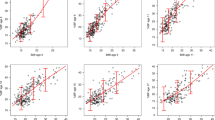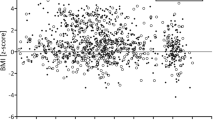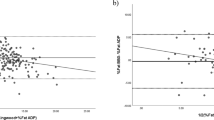Abstract
BACKGROUND: Body mass index (BMI) is widely used as an index of fatness in paediatrics, but previous analysis of the BMI–fatness relationship has been insufficient.
OBJECTIVE: To consider the effects of variation in fat‐free mass (FFM) and fat mass (FM) on BMI in infants, children and Fomon's reference child (Am J Clin Nutr 1982; 35: 1169–1175).
SUBJECTS: 42 infants aged 12 weeks; 64 children aged 8–12 y; Fomon's reference child.
METHODS: FFM was measured by deuterium dilution. FFM index (FFMI) and FM index (FMI) were calculated. The effects of variation in FFM and FM on BMI were explored using Hattori's body composition chart (Am J Hum Biol 1997; 9: 573–578).
RESULTS: In both infancy and childhood, a given BMI can embrace a wide range of percentage body fat. At both time points, the s.d. of FFMI was >60% of the s.d. of FMI. Graphic analysis differentiated the effects of lean tissue and fat deposition on BMI with age in the reference child.
CONCLUSION: Although valuable for assessing short‐term changes in nutritional status in individuals, and for comparing mean relative weight between populations, BMI is of limited use as a measure of body fatness in individuals in both infancy and childhood. The development of BMI with age may be disproportionately due to either FFM and FM at different time points.
This is a preview of subscription content, access via your institution
Access options
Subscribe to this journal
Receive 12 print issues and online access
$259.00 per year
only $21.58 per issue
Buy this article
- Purchase on Springer Link
- Instant access to full article PDF
Prices may be subject to local taxes which are calculated during checkout




Similar content being viewed by others
References
Goran MI, Driscoll P, Johnson R, Nagy TR, Hunter G . Cross‐calibration of body‐composition techniques against dual‐energy X‐ray absorptiometry in young children Am J Clin Nutr 1996 63: 299–305.
Davies PDW . Estimates of body fatness in infancy and childhood Am J Hum Biol 1992 4: 621–624.
Fiorotto ML, Cochran WJ, Klish WJ . Fat‐free mass and total body water of infants established from total body electrical conductivity measurements Pediatr Res 1987 22: 417–421.
Boileau RA, Lohman TG, Slaughter MH, Ball TE, Going SB, Hendrix MK . Hydration of the fat‐free body in children during maturation Hum Biol 1984 56: 651–666.
Hewitt MJ, Going SB, Williams DP, Lohman TG . Hydration of the fat‐free body mass in children and adults: implications for body composition assessment Am J Physiol 1993 265: E88–E95.
Wells JCK, Fuller NJ, Dewit O, Fewtrell MS, Elia M, Cole TJ . Four‐component model of body composition in children: density and hydration of fat‐free mass and comparison with simpler models Am J Clin Nutr 1999 69: 904–912.
Dietz WH, Robinson TN . Use of the body mass index (BMI) as a measure of overweight in children and adolescents. J Pediatr 1988 132: 191–193.
Prentice AM . Body mass index standards for children are useful for clinicians but not yet for epidemiologists Br Med J 17: 1401–1402.
Bland JM, Altman DG . Statistical methods for assessing agreement between 2 methods of clinical measurement Lancet 1986 i: 307–310.
Garrow JS, Webster J . Quetelet's index (W/H2) as a measure of fatness Int J Obes 1985 9: 147–153.
Fomon SJ, Haschke F, Ziegler EE, Nelson SE . Body composition of reference children from birth to age 10 years Am J Clin Nutr 1982 35: 1169–1175.
Van Itallie TB, Yang M, Heymsfield SB, Funk RC, Boileau RA . Height‐normalised indices of the body's fat‐free and fat fat mass: potentially useful indicators of nutritional status Am J Clin Nutr 1990 52: 953–959.
Hattori K, Tatsumi N, Tanaka S . Assessment of body composition by using a new chart method Am J Hum Biol 1997; 9: 573–578.
Hattori K . Body composition and lean body mass index for Japanese college students J Anthropol Soc Nippon 1991 99: 141–148.
Wells JCK, Davies PSW . Energy cost of physical activity in twelve week old infants Am J Hum Biol 1995 7: 85–92.
Wells JCK, Fewtrell MS, Jones SC, Cole TJ . Comparison of body composition by DXA and deuterium in children aged 5 to 11 years Pediatr Res 1996 40: A249.
Cole TJ, Freeman JV, Preece MA . Body mass index reference curves for the UK, 1990 Arch Dis Child 1995 73: 25–29.
Paul AA, Cole TJ, Ahmed EA, Whitehead RG . The need for revised standards for skinfold thickness in infancy Arch Dis Child 1998 78: 354–358.
Butte NF, Wong WW, Fiorotto M, O'Brian Smith E, Garza C . Influence of early feeding mode on body composition of infants Biol Neonate 1995 67: 414–424.
Goran MI, Allison DB, Poehlman ET . Issues relating to normalisation of body fat content in men and women Int J Obes 1995 19: 638–643.
Sarria A, Garcia‐Llop LA . Skinfold thickness measurements are better predictors of body fat percentage than body mass index in male Spanish children and adolescents Eur J Clin Nutr 1998 52: 573–576.
Chan YL, Leung SSF, Lam WWM, Peng XH, Metreweli C . Body fat estimation in children by magentic resonance imaging, bioelectrical impedance, skinfold and body mass index: a pilot study J Paediatr Child Health 1998 34: 22–28.
Pietrobelli A, Faith MS . Body mass index as a measure of adiposity among children and adolescents: a validation study J Pediatr 1998 132: 204–210.
Davies PSW, Lucas A . Quetelet's index as a measure of body fatness in young infants Early Hum Dev 1989 20: 135–141.
Daniels SR, Khoury PR, Morrison JA . The utility of body mass index as a measure of body fatness in children and adolescents: differences by race and gender Pediatrics 1997 99: 804–807.
Van den Broeck J, Wit J‐M . Anthropometry and body composition in children Hormone Res 1997 38 (Suppl 1): 33–42.
Warner JT, Cowan FJ, Dunstan FDJ, Gregory JW . The validity of body mass index for the assessment of adiposity in children with disease states Ann Hum Biol 1997 24:: 209–215.
Rolland‐Cachera M‐F, Deheeger M, Bellisle F, Sempé M, Guilloud‐Bataille M, Patoid E . Adiposity rebound in children: a simple indicator for predicting obesity Am J Clin Nutr 1984 39: 129–135.
Torun B, Viteri FE . Influence of exercise on linear growth Eur J Clin Nutr 1994 49 (Suppl 1): S186–189.
Vaisman N, Zadik Z, Akivias A, Voet H, Katz I, Yair S, Ashkenazi A . Changes in body composition, resting energy expenditure, and thermic effect of food in short children on growth hormone therapy Metabolism 1994 43: 1543–1548.
Andersen RE, Crespo CJ, Bartlett SJ, Cheskin LJ, Pratt M . Relationship of physical and television watching with body weight and level of fatness among children JAMA 1998 279: 938–942.
Stafford M, Wells JCK, Fewtrell MS . Television watching and fatness in children JAMA 1998 280: 1231–1232.
Schaefer F, Georgi M, Wühl E, Schärer K . Body mass index and percentage fat mass in healthy German schoolchildren and adolescents Int J Obes 1998 22: 461–469.
Garn SM, Leonard WR, Hawthorne VM . Three limitations of the body mass index Am J Clin Nutr 1986 44: 996–997.
Flegal KM . Defining obesity in children and adolescents: epidemiologic approaches Cr Rev Food Sci Nutr 1993 33: 307–312.
Power C, Lake JK, Cole TJ . Measurement and long‐term health risks of child and adolescent fatness Int J Obes 1997 21: 507–526.
Author information
Authors and Affiliations
Rights and permissions
About this article
Cite this article
Wells, J. A Hattori chart analysis of body mass index in infants and children. Int J Obes 24, 325–329 (2000). https://doi.org/10.1038/sj.ijo.0801132
Received:
Revised:
Accepted:
Published:
Issue Date:
DOI: https://doi.org/10.1038/sj.ijo.0801132
Keywords
This article is cited by
-
Reference values for body composition in healthy urban Mexican children and adolescents
European Journal of Clinical Nutrition (2023)
-
Association Between Age of Achieving Gross Motor Development Milestones During Infancy and Body Fat Percentage at 6 to 7 Years of Age
Maternal and Child Health Journal (2022)
-
Small-quantity lipid-based nutrient supplements, with or without added zinc, do not cause excessive fat deposition in Burkinabe children: results from a cluster-randomized community trial
European Journal of Nutrition (2022)
-
Nutritional status of school children living in Northern part of Sri Lanka
BMC Pediatrics (2021)
-
Quantifying childhood fat mass: comparison of a novel height-and-weight-based prediction approach with DXA and bioelectrical impedance
International Journal of Obesity (2021)



